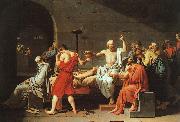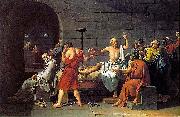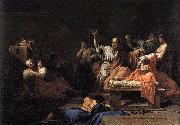
Oil On
Canvas, Real Flavor of Old Masters
|
Jacques-Louis David
|
|||
|
|
|||
| Jacques-Louis David, France Neoclassicism painter, b.1748 - d.1835. Jacques-Louis David is famous for his huge, dramatic canvasses of Napoleon and other historical figures, including Oath of the Horatii (1784), Death of Marat (1793) and The Sabine Women (1799). Early in his career he was a leader in the neoclassical movement; later his subjects became more modern and political. David was himself active in the French Revolution as a supporter of Robespierre and is sometimes called the chief propagandist for the Revolution; after the Reign of Terror ended he was briefly imprisoned for his actions. When Napoleon took power David became his court painter and created several grand canvasses of the Emperor, including the heroic Napoleon Bonaparte Crossing the Alps (1801) and the enormous Coronation of Napoleon and Josephine (1807). | |||
|
|
|||
|
|
The Death of Socrates new3/Jacques-Louis David_A5VaWT.jpg Painting ID:: 18977 Visit European Gallery |
1787, oil on canvas, The Metropolitan Museum of Art in New York | |
Height Width |
INS/CM |
||
|
X |
|
||
|
|
|||
|
Jacques-Louis David
|
|||
|
|
|||
| Jacques-Louis David, France Neoclassicism painter, b.1748 - d.1835. Jacques-Louis David is famous for his huge, dramatic canvasses of Napoleon and other historical figures, including Oath of the Horatii (1784), Death of Marat (1793) and The Sabine Women (1799). Early in his career he was a leader in the neoclassical movement; later his subjects became more modern and political. David was himself active in the French Revolution as a supporter of Robespierre and is sometimes called the chief propagandist for the Revolution; after the Reign of Terror ended he was briefly imprisoned for his actions. When Napoleon took power David became his court painter and created several grand canvasses of the Emperor, including the heroic Napoleon Bonaparte Crossing the Alps (1801) and the enormous Coronation of Napoleon and Josephine (1807). | |||
|
|
|||
|
|
The Death of Socrates new20/Jacques-Louis David-776399.jpg Painting ID:: 58550 Visit European Gallery |
The Death of Socrates (1787) | |
Height Width |
INS/CM |
||
|
X |
|
||
|
|
|||
|
unknow artist
|
|||
|
|
|||
|
|
|||
|
|
The Death of Socrates new21/unknow artist-389485.jpg Painting ID:: 62826 Visit European Gallery |
1787 Oil on canvas, 98 x 133 cm Statens Museum fur Kunst, Copenhagen Peyron's The Death of Socrates, commissioned by d'Angiviller for the Crown, was in competition with Jacques-Louis David's work of the same subject. David's confidence in surpassing his rival, coupled with his aggressive and ambitious nature, make it very possible that he chose to paint his own Socrates when he learned of Peyron's plans. The force and clarity of David's version was thrown into even sharper relief by the lack of drama and focus in Peyron's work, and both the public and critics declared David's work to be far superior. David eclipsed his long-time rival once and for all, and from then on Peyron had to be content with a subordinate role in the art world | |
Height Width |
INS/CM |
||
|
X |
|
||
|
|
|||
|
Jacques-Louis David
|
|||
|
|
|||
| French b.Aug. 30, 1748, Paris d.Dec. 29, 1825, Brussels Jacques-Louis David is famous for his huge, dramatic canvasses of Napoleon and other historical figures, including Oath of the Horatii (1784), Death of Marat (1793) and The Sabine Women (1799). Early in his career he was a leader in the neoclassical movement; later his subjects became more modern and political. David was himself active in the French Revolution as a supporter of Robespierre and is sometimes called the chief propagandist for the Revolution; after the Reign of Terror ended he was briefly imprisoned for his actions. When Napoleon took power David became his court painter and created several grand canvasses of the Emperor, including the heroic Napoleon Bonaparte Crossing the Alps (1801) and the enormous Coronation of Napoleon and Josephine (1807). David also painted Napoleon in His Study (1812), with its famous image of Napoleon with one hand tucked inside his vest. After Napoleon ouster David went in exile to Brussels, where he remained until his 1825 death | |||
|
|
|||
|
|
The Death of Socrates new24/Jacques-Louis David-796646.jpg Painting ID:: 84097 Visit European Gallery |
1787(1787) Medium Oil on canvas cyf | |
Height Width |
INS/CM |
||
|
X |
|
||
|
|
|||










